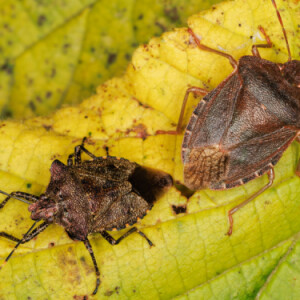Bronze
Well. This was a surprise. I've managed to tick off a few birding 'firsts' recently, but I wasn't expecting to turn up a new garden invertebrate this late in the year. I first spotted it yesterday, hanging out on one of the hazel trees in the wild garden in company with a Green Shieldbug, but I assumed it was a slightly odd-looking Red-legged Shieldbug, and didn't bother with it too much because it was nervous and I didn't want to cause it undue stress. But when I uploaded the shots I'd taken and looked at them on a big screen, I realised immediately that it wasn't a Red-legged Shieldbug - not least because it didn't have red legs, but also because it was more heavily punctured than I'd expect Pentatoma rufipes to be, and didn't have an orange mark at the end of the shield. It didn't take me long to identify it as a Bronze Shieldbug, but I wasn't happy with the photos, and it was too late in the day to try to take another set.
Memo to self: if something seems unusual, look again harder.
This morning, fingers crossed, I went back to the hazel tree, and luckily the two shieldbugs were still in the same spot, sheltering together beneath an overhanging leaf. I managed to tuck their cover out of the way for a couple of minutes, which was as long as it took to take a better set of photos. Then I gently replaced it, and the last sight I had of the Bronze Shieldbug was it peering out at me from underneath the edge. My second photo shows the two bugs together - the Bronze Shieldbug on the left, and the Green Shieldbug in its winter camouflage colours on the right.
The Bronze Shieldbug (Troilus lurida) is unusual in that it's one of just four predatory shieldbug species in the UK. It primarily inhabits woodland (another shout-out here to my tree-ringed wild garden), where it's found on both deciduous and coniferous trees, and though the nymphs start out by sucking sap from leaves of their host tree, they soon move on to attacking the larvae of moths and sawflies, as well as small invertebrates including beetles. It's believed that this higher protein diet is crucial to their ongoing development. Adults (which continue to be predatory) overwinter in leaf litter and mate in spring; eggs hatch in early summer, and adults begin to appear in late summer and early autumn.
I still maintain that this bug is superficially similar to the Red-legged Shieldbug in its general shape and appearance, and especially in the yellow spots around the connexivum. But as well as the differences I've already listed, it's a little smaller and rounder, and the prominences at the sides of its pronotum aren't as extreme as those of the Red-legged Shieldbug, which looks as though it's wearing 1980s shoulder pads. The Bronze Shieldbug is also quite noticeably mottled, and has a yellow ring around its penultimate antennal segment which is very distinctive. If you look at the main image full-screen you may be able to see that the front edge of the pronotum is jagged, which is also very unusual, though I believe that it varies quite a lot between different individuals.
Bronze Shieldbug larvae are colourful and become increasingly iridescent as they move through their moults, but though it would be fun to find some (not least as proof of breeding), in this garden in summer they have a large amount of high, fully-leafed canopy to hide in, so I'll be searching in hope, rather than expectation. British Bugs states that this species is common and widespread, but other sources comment that it's never found in great numbers, with the few that are seen on low branches like this likely to be just a fraction of the total number present.


Comments
Sign in or get an account to comment.


